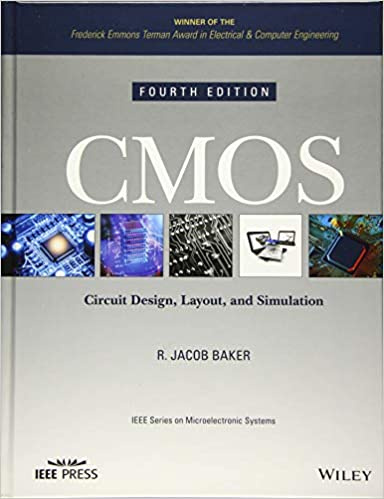VLSI
Reference Book
R. Jacob Baker
"CMOS: Circuit Design, Layout, and Simulation"
(IEEE Press Series on Microelectronic Systems)
4th Edition, Wiley, 2019

Course Software
- Electric: computer-aided design system for electrical circuits. It is primarily intended for integrated-circuit layout, but it also handles schematics and even textual hardware description languages
- LTSpice: high performance SPICE simulation software, schematic capture and waveform viewer with enhancements and models for easing the simulation of analog circuits.
Course Goals
- Design of Very Large Scale Integration (VLSI) systems.
- Examination of layout and simulation of digital VLSI circuits using a comprehensive set of CAD tools in a laboratory setting.
- Studies of layouts of CMOS combinational and sequential circuits using automatic layout generators.
- Fundamental structures of the layout of registers, adders, decoders, ROM, PLA's, counters, RAM and ALU.
- Application of statistics and probability to chip performance.
- Use CAD tools to perform logic verification and timing simulation of the circuits designed.
Course Modules
Module 1 - Introduction
- Silicon structure
- nMOS and pMOS
- Basic logic gates structure
- CMOS Fabrication
- Layout
Module 2 - Circuits and Layouts
- CMOS gate design
- Pass transistors
- CMOS latches and flip-flops
- Standard cell layouts
- Stick diagrams
Module 3 - The Well
- Patterning
- Laying Out the N-well
- Resistance calculation
- The RC delay through the N-well
Module 4 - The Metal Layers
- The bonding pad
- Design and layout using the metal layers
Module 5 - The Active and Poly Layers
- Layout using the active and poly layers
- Connecting wires to poly and active
- Layout of an NMOS and PMOS device
- Standard cell frame
- Design rules
- ESD protection
Module 6 - The Inverter
- DC Characteristics
- Switching Characteristics
- Layout of the inverter
Module 7 - Static Logic Gates
- DC Characteristics of the NAND and NOR gates
- Layout of the NAND and NOR gates
- Complex CMOS logic gates
Module 8 - Special Purpose Circuits
- The Schmitt Trigger
- Multivibrators Circuits
- Input Buffers
- Charge Pumps
Module 9 - Physical Design
- Floorplan, power plan, placements, clock tree synthesis, routing, static timing analysis
- Verification and Analysis